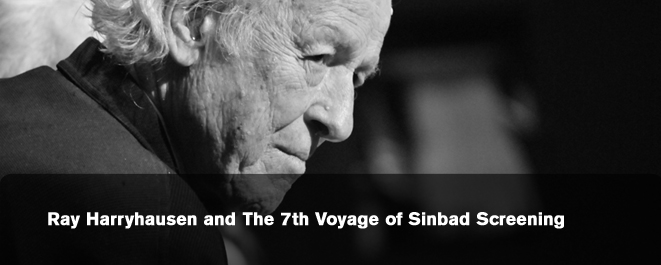|
What a
week! First Spielberg, now Harryhausen!
The American Cinematheque and Arnold Kunert held a
tribute to the visual effects icon, Ray Harryhausen.
This included a book signing at the Every Picture
Tells A Story bookstore, and a screening with live
commentary at the Aero Theatre in Santa Monica, CA on
February 17, 2008. The book signing filled the
quaint bookstore almost to capacity, and sold out
the Aero located across the street. Lines snaked
down Montana Avenue and around the corner. The
winter chill of Santa Monica wouldn't stop die hard
fans of Harryhausen.
Fans were given two opportunities to see Harryhausen
in-person. One was at Every Picture Tells A Story,
in which fans asked him to sign posters, books, and
figurines. Two was across the street at the Aero
Theatre, where fans got a chance to watch "The 7th
Voyage of Sinbad" (1958) with a live commentary with
Harryhausen, Kunert, Phil Tippett, Randy Cook,
actress Kathryn Grant (who played Princess Parisia),
and biographer Steven Smith. The show was a lot of
fun and very interactive for the audience. People
were allowed to shout out questions to the panel.
One lady even asked for the projectionist to turn up
the dialogue on the movie. She was politely "booed"
by the audience. Harryhausen was charming in
answering questions during the film presentation.
Harryhausen didn't invent stop-motion animation, but
he certainly refined it and made it his own. For
many years, visual effects were relegated to
B-movies and seen by many as simple diversions,
rather than artistic achievement. Harryhausen, among
many visual effects artists of the 1950s and 1960s,
carried on with their craft and created some of the
most memorable images in cinematic history.
Harryhausen, with his keen eye on detail and
personality in his amazing creatures, set a high
standard for visual effects. His creatures weren't
merely animated to look like a neat effect. They
lived and breathed, hurt and cried out in pain. Some
of the visual effects today, although extraordinary
in their believability and technical prowess, lack
the charm of Harryhausen's creations.
One of my favorite Harryhausen creations is that of
the skeleton warriors in "Jason and the Argonauts"
(1963). Those skeletons scared me as a kid, yet
totally fascinated me, too! It was noted during the
live commentary that Harryhausen's skeletons had
that "Harryhausen frown." His skeletons usually had
a mean scowl on their boney faces, and down right
looked creepy and cool. I guess I wasn't the only
one who thought Harryhausen's skinless warriors were
a bit frightening.
"I don't know why everybody's afraid of skeletons,"
paraphrasing Harryhausen that evening. "Everybody's
got one!"
Numerous visual effects artists of today cite
Harryhausen as a huge influence, if not the
influence on their career direction. "Monsters Inc."
(2001) has a playful reference to Ray. Phil Tippett
and Dennis Muren (who was supposed to be on-hand had
to bow out due to the flu) are among Harryhausen's
elite disciples.
It was a delight to see Harryhausen, who in his
eighties, still works his animation magic. |



